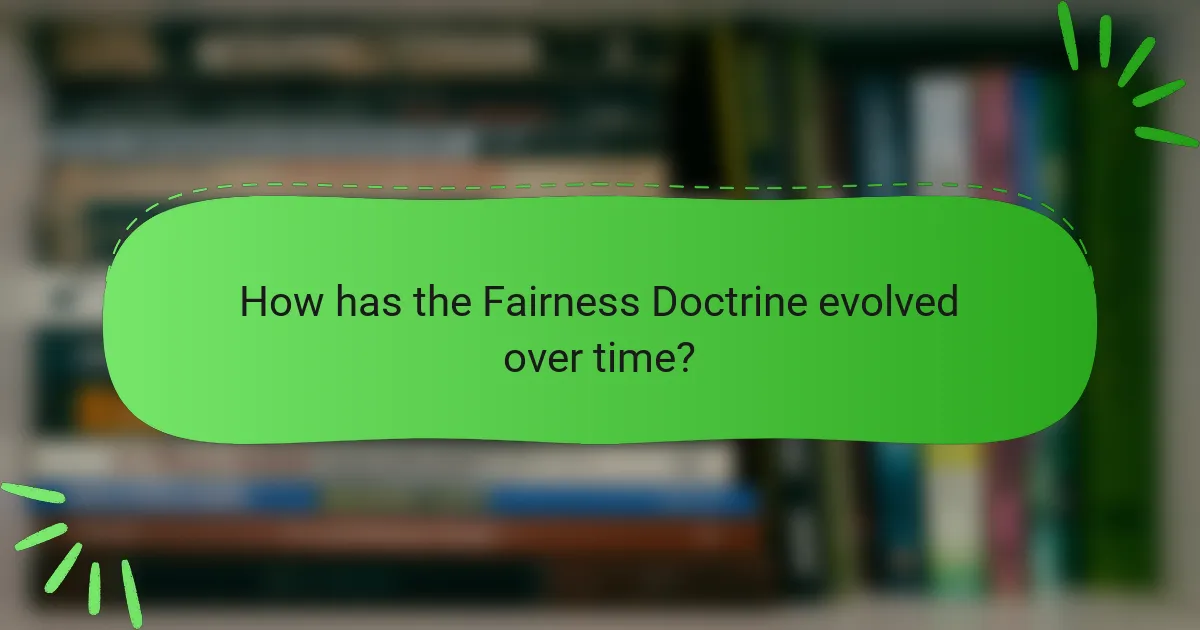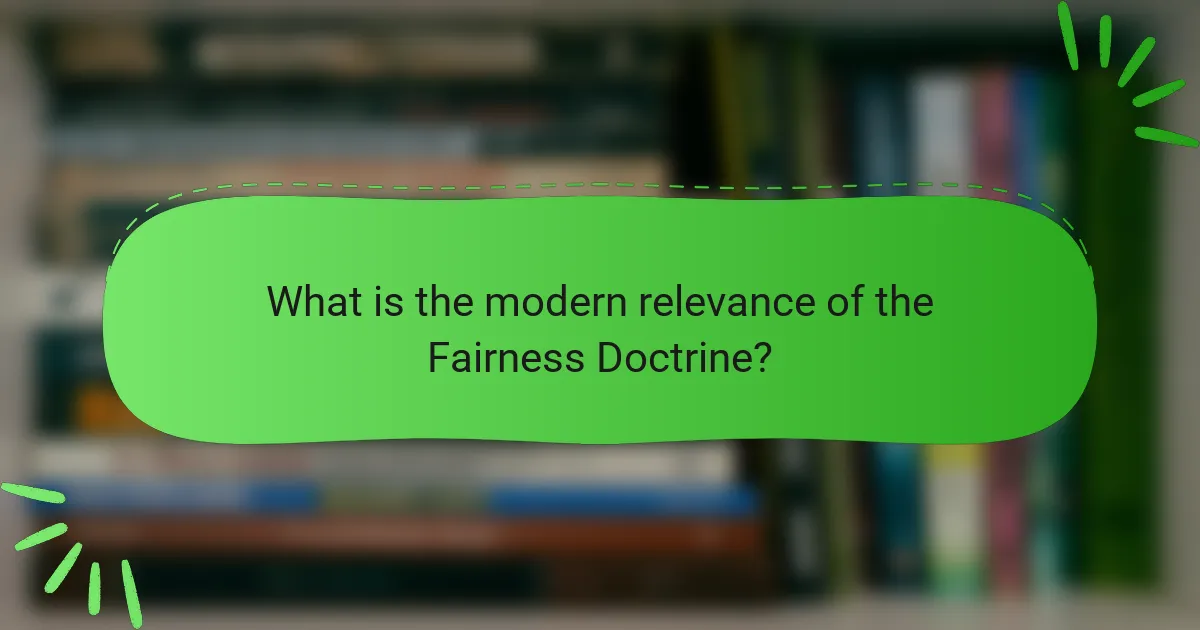The Fairness Doctrine was a policy implemented by the Federal Communications Commission (FCC) in 1949, mandating that broadcasters present controversial public issues in a balanced manner to ensure diverse viewpoints were represented. This policy aimed to foster equitable discourse in media but was abolished in 1987 due to concerns that it restricted free speech and was no longer necessary in a landscape with multiple media outlets. The repeal has led to ongoing discussions about media responsibility, the potential for bias, and the need for balanced reporting in today’s fragmented media environment. The article will explore the historical context of the Fairness Doctrine, its impact on media practices, and its relevance in contemporary debates about media accountability and diversity of viewpoints.

What is the Fairness Doctrine?
The Fairness Doctrine was a policy introduced by the Federal Communications Commission (FCC) in 1949. It required broadcasters to present controversial issues of public importance in a balanced manner. The policy aimed to ensure that differing viewpoints were represented on the airwaves. This was to promote a fair and equitable discourse in broadcasting. The Fairness Doctrine was eliminated in 1987 by the FCC. The decision was based on the belief that it restricted free speech. The repeal sparked debates about media responsibility and diversity of viewpoints.
How did the Fairness Doctrine originate?
The Fairness Doctrine originated in the United States in the 1940s. It was established by the Federal Communications Commission (FCC) to ensure balanced coverage of controversial issues. The doctrine required broadcasters to present opposing viewpoints on significant public issues. This was aimed at promoting fairness in broadcasting and preventing the monopolization of opinions. The Fairness Doctrine was formally adopted in 1949. It was justified by the need to serve the public interest in a diverse media landscape. The doctrine remained in effect until it was abolished in 1987. Its repeal was based on the belief that it was no longer necessary in a more competitive media environment.
What historical events led to the establishment of the Fairness Doctrine?
The Fairness Doctrine was established in response to the need for balanced public discourse in broadcasting. Its origins trace back to the 1940s during the rise of radio and television. The Federal Communications Commission (FCC) recognized the potential for media monopolies to shape public opinion. In 1949, the FCC adopted the Fairness Doctrine to ensure diverse viewpoints were represented. This was influenced by concerns over political bias in media coverage. The doctrine required broadcasters to present controversial issues fairly and provide opposing viewpoints. It aimed to promote democratic participation and informed citizenship. The Fairness Doctrine was officially eliminated in 1987, but its historical context remains relevant in discussions about media responsibility today.
Who were the key figures involved in its creation?
The key figures involved in the creation of the Fairness Doctrine were policymakers and regulatory officials from the Federal Communications Commission (FCC). The doctrine was established in 1949 under the leadership of FCC Chairman Paul A. Walker. It aimed to promote diverse viewpoints in broadcasting. Additionally, the doctrine was influenced by the work of FCC commissioners, including John C. Doerfer and Robert E. Lee. Their contributions shaped the framework for ensuring fair and balanced media coverage. The Fairness Doctrine was officially eliminated in 1987, reflecting changes in media regulation.
What were the main principles of the Fairness Doctrine?
The Fairness Doctrine was a policy that required broadcasters to present contrasting viewpoints on controversial issues. Its main principles included the obligation to provide balanced coverage and the necessity of presenting opposing perspectives. This doctrine aimed to ensure that the public received a diverse range of opinions. It was implemented by the Federal Communications Commission (FCC) in 1949. The Fairness Doctrine was based on the belief that access to multiple viewpoints is essential for democracy. It was abolished in 1987, leading to debates about media responsibility. The doctrine’s principles were intended to promote fairness in broadcasting.
How did the Fairness Doctrine define fairness in broadcasting?
The Fairness Doctrine defined fairness in broadcasting as the requirement for broadcasters to present contrasting viewpoints on controversial issues. It mandated that broadcasters provide airtime for opposing perspectives. This was intended to ensure that the public received a balanced view of important topics. The Federal Communications Commission (FCC) implemented the doctrine in 1949. It aimed to promote responsible journalism and prevent the monopolization of public discourse. Broadcasters were required to disclose their editorial policies. This approach was based on the belief that access to diverse opinions is essential for a democratic society. The doctrine was abolished in 1987, leading to ongoing debates about media fairness.
What obligations did the Fairness Doctrine impose on broadcasters?
The Fairness Doctrine imposed obligations on broadcasters to present contrasting viewpoints on controversial issues. This regulation required broadcasters to provide balanced coverage and ensure that all sides of a debate were represented. Broadcasters had to air programs that addressed significant public issues. They were also required to offer opportunities for the public to respond to those issues. The doctrine aimed to promote fair and equitable discussion in the media. It was established by the Federal Communications Commission (FCC) in 1949. The Fairness Doctrine was abolished in 1987, but its impact on media practices remains significant.
Why was the Fairness Doctrine significant in media regulation?
The Fairness Doctrine was significant in media regulation because it mandated broadcasters to present balanced viewpoints on controversial issues. This policy aimed to ensure that diverse perspectives were represented in the media. It required broadcasters to provide equal airtime for opposing views. The Federal Communications Commission (FCC) implemented the doctrine in 1949. Its intention was to promote informed public discourse. The Fairness Doctrine influenced how news was reported and discussed. It was repealed in 1987, leading to concerns about media polarization. The legacy of the Fairness Doctrine continues to impact discussions on media ethics and regulation today.
What impact did the Fairness Doctrine have on public discourse?
The Fairness Doctrine significantly influenced public discourse by promoting balanced coverage of controversial issues. It required broadcasters to present opposing viewpoints on political matters. This regulation aimed to ensure that audiences received diverse perspectives. As a result, media outlets were compelled to address multiple sides of a debate. The Fairness Doctrine was enacted in 1949 and enforced until 1987. During its existence, it fostered a more informed public. Critics argue that its removal led to increased partisanship in media. Studies indicated that without the doctrine, media became more polarized, affecting public opinion.
How did it influence the diversity of viewpoints in media?
The Fairness Doctrine significantly influenced the diversity of viewpoints in media by requiring broadcasters to present contrasting perspectives on controversial issues. This regulation aimed to ensure that audiences received a balanced view, promoting a variety of opinions. It mandated that if a station aired one side of a debate, it had to provide airtime for opposing views. As a result, this led to increased representation of minority opinions and a broader spectrum of discourse in public media. The implementation of the Fairness Doctrine contributed to a more informed citizenry by exposing audiences to multiple viewpoints. Studies indicated that the presence of this doctrine correlated with a rise in diverse programming and discussions in television and radio. The removal of the Fairness Doctrine in 1987 has since been linked to a decline in this diversity, as media outlets increasingly cater to specific audiences without the obligation to present opposing views.

How has the Fairness Doctrine evolved over time?
The Fairness Doctrine has evolved significantly since its inception. Established in 1949 by the Federal Communications Commission (FCC), it required broadcasters to present contrasting viewpoints on controversial issues. The doctrine aimed to ensure a balanced representation of diverse opinions in media.
In 1987, the FCC abolished the Fairness Doctrine, citing that it restricted free speech and did not serve the public interest. The repeal was influenced by the rise of cable television and the belief that multiple media outlets provided sufficient diversity of views.
Since then, the media landscape has transformed with the advent of the internet and social media. This shift has created new challenges regarding balanced discourse. Some argue for the revival of the doctrine to address perceived biases in contemporary media.
However, as of now, the Fairness Doctrine remains absent from regulatory frameworks. The evolution reflects ongoing debates about media responsibility and free expression.
What were the key changes to the Fairness Doctrine in its history?
The Fairness Doctrine underwent significant changes since its inception. Established by the Federal Communications Commission (FCC) in 1949, it required broadcasters to present contrasting viewpoints on controversial issues. In the 1980s, the FCC began to relax enforcement. In 1987, the FCC officially abolished the Fairness Doctrine. This decision was based on the belief that it restricted free speech and limited the diversity of viewpoints. The repeal led to a rise in opinion-based programming. Critics argue that this change contributed to increased polarization in media. The Fairness Doctrine’s legacy remains a topic of debate in discussions about media responsibility.
What factors contributed to the decline of the Fairness Doctrine?
The decline of the Fairness Doctrine was influenced by several key factors. One major factor was the changing political landscape in the United States during the 1980s. The Reagan administration, which favored deregulation, pushed for a reduction in government oversight of media. This shift in policy led the Federal Communications Commission (FCC) to reassess the necessity of the Fairness Doctrine.
Additionally, the rise of cable television and the internet introduced more diverse viewpoints and platforms. This diversification made the Fairness Doctrine seem less relevant. In 1987, the FCC officially eliminated the doctrine, arguing that it restricted broadcasters’ free speech rights. The decision was supported by the belief that the marketplace of ideas would naturally balance viewpoints without government intervention.
These factors combined to create an environment where the Fairness Doctrine was deemed outdated and unnecessary.
When was the Fairness Doctrine officially abolished?
The Fairness Doctrine was officially abolished on August 4, 1987. The Federal Communications Commission (FCC) made this decision. The repeal was based on the belief that it restricted free speech. The FCC argued that the doctrine was no longer necessary in a diverse media landscape. This action led to significant changes in broadcasting regulations. The Fairness Doctrine had required broadcasters to present contrasting viewpoints on controversial issues. Its abolition marked a shift towards a more deregulated broadcasting environment.
How do modern media practices reflect the legacy of the Fairness Doctrine?
Modern media practices reflect the legacy of the Fairness Doctrine through increased emphasis on balanced reporting. The Fairness Doctrine, established in 1949, required broadcasters to present contrasting viewpoints on controversial issues. Today, media outlets strive for balance to maintain credibility and audience trust. Many news organizations implement editorial guidelines promoting fairness and objectivity. Social media platforms also face pressure to moderate content and ensure diverse perspectives. This mirrors the Fairness Doctrine’s intent to foster informed public discourse. Research shows that audiences prefer sources that present multiple viewpoints, reinforcing the need for balanced reporting. The ongoing debate about misinformation highlights the relevance of fairness in today’s media landscape.
What parallels can be drawn between the Fairness Doctrine and current regulations?
The Fairness Doctrine and current regulations both aim to ensure balanced viewpoints in media. The Fairness Doctrine required broadcasters to present contrasting views on controversial issues. Similarly, current regulations encourage diverse perspectives through policies like the FCC’s localism initiatives. Both frameworks seek to prevent monopolization of opinions in public discourse. The Fairness Doctrine was eliminated in 1987, but its principles resonate in today’s discussions on media responsibility. Current regulations, such as content moderation policies on social media, reflect similar concerns about misinformation and bias. Both approaches highlight the ongoing challenge of maintaining a fair media landscape.
How do contemporary media platforms address fairness and balance?
Contemporary media platforms address fairness and balance through editorial guidelines and diverse content sourcing. They implement policies that promote impartial reporting and representation of multiple viewpoints. For instance, many platforms encourage fact-checking and corrections to enhance credibility. Algorithms often prioritize diverse perspectives in news feeds to prevent echo chambers. Research indicates that platforms like Facebook and Twitter have developed tools to flag misinformation, promoting balanced discourse. Additionally, content creators are encouraged to present opposing views to foster a more comprehensive understanding of issues. These practices aim to uphold journalistic integrity and public trust.

What is the modern relevance of the Fairness Doctrine?
The Fairness Doctrine is relevant today as it raises discussions about media bias and accountability. This policy, established in 1949, required broadcasters to present contrasting views on controversial issues. Its repeal in 1987 led to concerns about the decline of balanced reporting. Critics argue that without such regulations, media outlets can promote partisan narratives. Proponents of reinstating the doctrine believe it could enhance public discourse. Research indicates a correlation between media diversity and informed citizenry. The ongoing debate reflects the challenge of ensuring fair representation in today’s fragmented media landscape.
How do critics view the absence of the Fairness Doctrine today?
Critics view the absence of the Fairness Doctrine as detrimental to public discourse. They argue that it has led to increased polarization in media. Without the doctrine, broadcasters have less incentive to present diverse viewpoints. This absence is seen as contributing to echo chambers in news consumption. Critics also claim that misinformation spreads more easily without regulatory oversight. They believe that the Fairness Doctrine could help restore balance in reporting. Some advocate for its reinstatement to promote informed citizenship. Overall, critics express concern over the implications for democracy and civic engagement.
What concerns have arisen regarding media bias in the current landscape?
Concerns regarding media bias in the current landscape include the perception of partisan reporting. Many audiences believe that news outlets favor specific political viewpoints. This bias can lead to misinformation and polarization among the public. Research indicates that 62% of Americans feel news organizations are politically biased. Furthermore, social media algorithms often amplify biased content, creating echo chambers. The lack of diversity in newsroom staff also contributes to biased perspectives. This has raised questions about journalistic integrity and accountability. Overall, these concerns highlight the challenges of maintaining objectivity in modern media.
How do proponents argue for the reintroduction of the Fairness Doctrine?
Proponents argue for the reintroduction of the Fairness Doctrine by emphasizing the need for balanced media coverage. They believe it can reduce media polarization. Supporters claim that diverse viewpoints in broadcasting promote informed public discourse. Historical context shows that the Fairness Doctrine was effective in ensuring varied perspectives. Data from the 1980s indicates a rise in partisan media after its repeal. Advocates assert that reinstating the doctrine could enhance democracy. They reference studies linking media diversity to increased civic engagement. Proponents argue that it is essential for a healthy democratic society.
What lessons can be learned from the Fairness Doctrine for today’s media?
The Fairness Doctrine teaches today’s media the importance of presenting diverse viewpoints. It emphasized the need for balanced reporting. This doctrine required broadcasters to air contrasting opinions on controversial issues. Enforcing this principle fostered a more informed public. The Fairness Doctrine was in effect from 1949 until its repeal in 1987. Its absence has led to increased polarization in media. Many argue that reinstating similar standards could enhance media accountability. This could potentially restore public trust in journalism.
How can media outlets ensure diverse perspectives without the Fairness Doctrine?
Media outlets can ensure diverse perspectives by implementing editorial policies that prioritize inclusivity. They can actively seek out voices from underrepresented communities. Collaborating with independent journalists can also broaden coverage. Providing platforms for guest opinions fosters a variety of viewpoints. Utilizing audience feedback can guide content diversity. Transparency in sourcing and reporting builds trust and encourages diverse contributions. Studies show that diverse newsrooms produce more comprehensive coverage. For instance, a 2019 report by the American Society of News Editors highlighted that diversity in journalism leads to better storytelling and engagement.
What best practices can be adopted to promote fairness in modern media?
Implementing transparency in sourcing is a best practice for promoting fairness in modern media. This involves clearly attributing information to credible sources. It helps audiences assess the reliability of the content. Ensuring diverse representation in media coverage is also crucial. This includes featuring voices from various backgrounds and perspectives. It fosters a more inclusive narrative.
Fact-checking is essential for maintaining accuracy. Media organizations should employ dedicated fact-checkers. This reduces the spread of misinformation. Providing balanced viewpoints on contentious issues is another key practice. This ensures that multiple sides of a story are presented fairly.
Audience engagement is important for promoting fairness. Media outlets should encourage feedback from their audiences. This helps identify biases and areas for improvement. Regular training on ethical journalism standards for staff is also beneficial. It reinforces the commitment to fair reporting practices.
Adopting these practices can enhance the integrity of modern media. They help build trust with the audience, which is vital for a healthy media landscape.
The Fairness Doctrine was a policy established by the Federal Communications Commission (FCC) in 1949, requiring broadcasters to present controversial issues in a balanced manner by including opposing viewpoints. This article analyzes the historical context of the Fairness Doctrine, its key principles, and the significant figures involved in its creation, as well as the implications of its repeal in 1987. It further explores the doctrine’s impact on public discourse and media diversity, alongside contemporary debates regarding media bias and the potential reintroduction of similar regulations to promote fairness in today’s media landscape. Insights into best practices for ensuring diverse perspectives in modern media are also discussed.